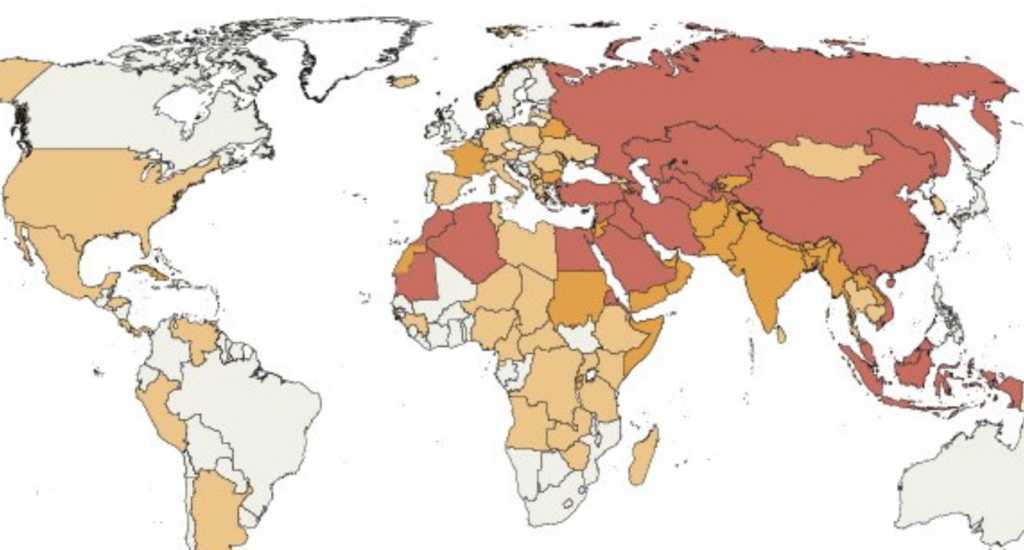A new map released by the Pew Research Center shows the troubling state of religious freedom across the globe, with government restrictions on faith and social hostilities plaguing substantial portions of the world.
The polling firm also found in its new report that these indicators, for the first time in three years, worsened in 2015; it’s a change that comes after there were actually decreases for two years in both government restrictions and social hostilities against religion.
“The share of countries with ‘high’ or ‘very high’ levels of government restrictions – i.e., laws, policies and actions that restrict religious beliefs and practices – ticked up from 24 percent in 2014 to 25 percent in 2015,” the report read. “Meanwhile, the percentage of countries with high or very high levels of social hostilities – i.e., acts of religious hostility by private individuals, organizations or groups in society – increased in 2015, from 23 percent to 27 percent.”
In sum, 40 percent of countries had high or very high restrictions in one of these two areas, up from 34 percent in 2014. To examine the issue another way: In 2015, there were 50 countries with high or very high religious restrictions, up from 47 in 2014; likewise, there were 53 countries with high or very high social hostilities surrounding religion, up from 45 in 2014.
Here’s the map that gives a virtual glimpse into what this all looks like:
Government restrictions on religion around the world, in one map (from new report: https://t.co/QEG0xEgV4Y) pic.twitter.com/hWlp5gLl10
— Pew Research Religion (@PewReligion) April 11, 2017
The metrics surrounding government restrictions will certainly be seen as troubling to humanitarians and others working to combat religious discrimination and violence across the globe. And, after glancing at the overall metrics, that’s understandable.
Consider that, of 198 countries included in Pew’s analysis, 105 fell into the category of widespread government harassment of religious groups. That’s a jump from 85 in 2014 and 96 in 2013, as the study noted.
The Middle East remains the place with the highest concentration of government harassment against religious groups, though Europe is home to the fastest increase among these measures.
Some incidents and statements from governments and officials in Europe have followed radical Islamic terror attacks, leading a dynamic in which officials and countries have oft-times cracked down on religious groups within their borders. And as the influx of immigrants arrive from Syria, Iraq and other locations, this problem has reportedly only exacerbated.
For instance, the study offers the example of a 2015 police raid on a mosque in Germany after authorities suspected there was an extremist there who was handing out automatic weapons in the effort to bring about a terror attack. After police raided the mosque and handcuffed Muslims inside, no guns were found and the operation was later deemed improper.
On the flip side, terror attacks at the hands of religious individuals are also included in the analysis. The study notes:
Attacks that were influenced by religion, such as those in Paris, are counted in the study as social hostilities involving religion – i.e., hostile actions motivated by religion and carried out by individuals or social groups, separate from government actions. In Europe, hostilities toward Muslims in particular increased considerably. In 2015, 32 countries in Europe (71%) experienced social hostilities toward Muslims, up from 26 countries (58%) in 2014. By comparison, social hostilities toward Christians spread from 17 (38%) countries in 2014 to 21 (47%) in 2015. Hostilities against Jews in Europe remained common and increased slightly, from 32 (71%) countries in 2014 to 33 (73%) countries in 2015. Many of the incidents targeting these religious groups occurred in the form of mob violence.
You can read Pew’s entire analysis here.
—
Other Must-Read Stories:
– Olympic Gymnast Simone Biles’ ‘DWTS’ Performance to Famed Christian Song Left the Audience in Tears
– The Origins of the Easter Bunny: Where Did This Bizarre Tradition Begin?



